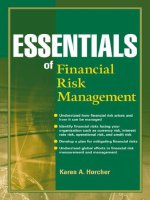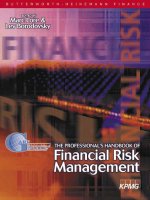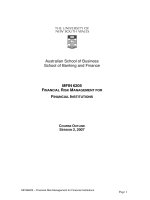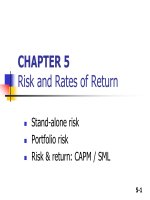Elements of financial risk management chapter 5
Bạn đang xem bản rút gọn của tài liệu. Xem và tải ngay bản đầy đủ của tài liệu tại đây (1.03 MB, 79 trang )
1
Volatility Modeling
Using Intraday Data
Elements of
Financial Risk Management
Chapter 5
Peter Christoffersen
Elements of Financial Risk Management Second Edition © 2012 by Peter Christoffersen
Overview
• Our goal is to harness the information in intraday
prices for computing daily volatility
• Let us estimate the mean of returns using a long
sample of daily observations:
• When estimating the mean of returns only the
first and the last observations matter as all the
intermediate terms cancel out
• When estimating the mean, we need a long time
span of data
Elements of Financial Risk Management Second Edition © 2012 by Peter Christoffersen
2
Overview
• The start and end points S0 and ST will be the same
irrespective of the sampling frequency of returns
• Consider now instead estimating variance on a sample of
daily returns:
• In the variance estimator, the intermediate prices do not
cancel out
• All return observations now matter because they are
squared before they are summed in the average.
Elements of Financial Risk Management Second Edition © 2012 by Peter Christoffersen
3
Overview
• Now we have price observations at the end of every
hour instead of every day and the market for the asset at
hand is open 24 hours a day
• Now we have 24.T observations to estimate 2 and we
can get a much more precise estimate than when using
just the T daily returns
• Implication of this high-frequency sampling is that just
as we can use 21 daily prices to estimate a monthly
volatility we can also use 24 hourly observations to
estimate a daily volatility
Elements of Financial Risk Management Second Edition © 2012 by Peter Christoffersen
4
5
Realized Variance: Four Stylized Facts
• Assume that we are monitoring an asset that trades 24
hours per day and that it is extremely liquid so that bid-ask
spreads are virtually zero and new information is reflected
in the price immediately
• Let m be the number of observations per day on an asset.
If we have 24 hour trading and 1-minute observations,
then m = 24*60 = 1,440
• Let the jth observation on day t+1 be denoted St+j/m. Then
the closing price on day t+1 is St+m/m = St+1, and the jth 1minute return is
Elements of Financial Risk Management Second Edition © 2012 by Peter Christoffersen
6
Realized Variance: Four Stylized Facts
• With m observations daily, we can calculate an estimate
of the daily variance from the intraday squared returns
simply as
• Here we do not divide the sum of squared returns by m.
If we did we would get a 1-minute variance.
• This is the total variance for a 24-hour period
• Here we do not subtract the mean of the 1-minute returns
as it is so small that it will not impact the variance
estimate.
Elements of Financial Risk Management Second Edition © 2012 by Peter Christoffersen
Realized Variance: Four Stylized Facts
7
• The top panel of Figure 5.1 shows the time series of daily
realized S&P 500 variance computed from intraday
squared returns.
• The bottom panel shows the daily close-to-close squared
returns of S&P 500.
• The squared returns in the bottom panel are much more
jagged and noisy when compared with the realized
variances in the top panel.
• Figure 5.1 illustrates the first stylized fact of RV: RVs are
much more precise indicators of daily variance than are
daily squared returns.
Elements of Financial Risk Management Second Edition © 2012 by Peter Christoffersen
Figure 5.1: Realized Variance (top) and Squared
Returns (bottom) of the S&P500.
Elements of Financial Risk Management Second Edition © 2012 by Peter Christoffersen
8
Realized Variance: Four Stylized Facts
9
• The top panel of Figure 5.2 shows the autocorrelation
function of the S&P 500 RV series from Figure 5.1
• The bottom panel shows the corresponding ACF computed
from daily squared returns
• Notice how much more striking the evidence of variance
persistence is in the top panel.
• Figure 5.2 illustrates the second stylized fact of RV:
• RV is extremely persistent, which suggests that volatility
may be forecastable at horizons beyond a few months as
long as the information in intraday returns is used
Elements of Financial Risk Management Second Edition © 2012 by Peter Christoffersen
Figure 5.2: Autocorrelation of Realized Variance and
Autocorrelation of Squared Returns
Elements of Financial Risk Management Second Edition © 2012 by Peter Christoffersen
10
Realized Variance: Four Stylized Facts
11
• The top panel of Figure 5.3 shows a histogram of the RVs
from Figure 5.1
• The bottom panel of Figure 5.3 shows the histogram of
the natural logarithm of RV
• Figure 5.3 shows that the logarithm of RV is very close to
normally distributed whereas the level of RV is strongly
positively skewed with a long right tail
Elements of Financial Risk Management Second Edition © 2012 by Peter Christoffersen
Figure 5.3. Histogram of Realized Variance and log
Realized Variance
Elements of Financial Risk Management Second Edition © 2012 by Peter Christoffersen
12
13
Realized Variance: Four Stylized Facts
• The approximate log normal property of RV is the third
stylized fact. We can write
• The fourth stylized fact of RV is that daily returns
divided by the square root of RV is very close to
following an i.i.d. (independently and identically
distributed) standard normal distribution:
Elements of Financial Risk Management Second Edition © 2012 by Peter Christoffersen
14
Realized Variance: Four Stylized Facts
• RVmt+1 can only be computed at the end of day t+1, So this
result is not immediately useful for forecasting purposes
• If a good forecast RVmt+1/t can be made using information
available at time t then a normal distribution assumption
of
will be a decent first modeling strategy.
Approximately:
• where we have now standardized the return with the RV
forecast
Elements of Financial Risk Management Second Edition © 2012 by Peter Christoffersen
Realized Variance: Four Stylized Facts
15
• When constructing a good forecast for RVmt+1 , we need to
keep in mind the four stylized facts of RV:
– RV is a more precise indicator of daily variance than is
the daily squared return.
– RV has large positive autocorrelations for many lags.
– The log of RV is approximately normally distributed.
– The daily return divided by the square root of RV is
close to i.i.d. standard normal.
Elements of Financial Risk Management Second Edition © 2012 by Peter Christoffersen
Forecasting Realized Variance
• Realized variances are very persistent
• So we need to consider forecasting models that
allow for current RV to matter for future RV
Elements of Financial Risk Management Second Edition © 2012 by Peter Christoffersen
16
Simple ARMA Models of Realized Variance
17
• AR(1) model allows for persistence in a time series
• If we treat the estimated RVmt as an observed time series,
then we can assume the AR(1) forecasting model
• where t+1 is assumed to be uncorrelated over time and
have zero mean
• The parameters 0 and 1 can easily be estimated using
OLS.
• The one-day-ahead forecast of RV is then
Elements of Financial Risk Management Second Edition © 2012 by Peter Christoffersen
18
Simple ARMA Models of Realized Variance
• Since the log of RV is close to normally distributed we
may be better off modeling the RV in logs rather than
levels. We can therefore assume
• The normal property of ln (RVmt+1) will make the OLS
estimates of 0 and 1 better than those in the AR(1)
model for RVmt+1
• The AR(1) errors, t+1, are likely to have fat tails, which
in turn yield noisy parameter estimates
Elements of Financial Risk Management Second Edition © 2012 by Peter Christoffersen
Simple ARMA Models of Realized Variance
19
• As we have estimated it from intraday squared returns, the
RVmt+1 is not truly an observed time series but it can be
viewed as the true RV observed with a measurement error.
• If the true RV is AR(1) but we observed true RV plus an
i.i.d. measurement error then an ARMA(1,1) model is
likely to provide a good fit to the observed RV. We can
write
• which due to the MA term must be estimated using
maximum likelihood techniques
Elements of Financial Risk Management Second Edition © 2012 by Peter Christoffersen
20
Simple ARMA Models of Realized Variance
• As the exponential function is not linear, we have in the
log RV model that
• Assuming normality of the error term we can use:
• In the AR(1) model the forecast for tomorrow is
Elements of Financial Risk Management Second Edition © 2012 by Peter Christoffersen
Simple ARMA Models of Realized Variance
21
• And for the ARMA(1,1) model we get,
• More sophisticated models such as long-memory ARMA
models can be used to model realized variance
• These models may yield better longer horizon variance
forecasts than the short-memory ARMA models
considered here
Elements of Financial Risk Management Second Edition © 2012 by Peter Christoffersen
22
Heterogeneous Autoregressions (HAR)
• Mixed-frequency or heterogeneous auto-regression model
(HAR) helps us to parsimoniously and easily model the longmemory features of realized volatility
• Consider the h-day RV from the 1-day RV as follows:
• where dividing by h makes RVt-h+1,t interpretable as the
average total variance starting with day t-h+1 and through
day t.
Elements of Financial Risk Management Second Edition © 2012 by Peter Christoffersen
23
Heterogeneous Autoregressions (HAR)
• Consider forecasting tomorrow’s RV using daily, weekly,
and monthly RV defined by the simple moving averages
• where we have assumed five trading days in a week and
21 trading days in a month
Elements of Financial Risk Management Second Edition © 2012 by Peter Christoffersen
24
Heterogeneous Autoregressions (HAR)
• The simplest way to forecast RV with these variables is
via the regression which defines the HAR model
• Note that HAR can be estimated by OLS because all
variables are observed and because the model is linear in
the parameters
Elements of Financial Risk Management Second Edition © 2012 by Peter Christoffersen
Heterogeneous Autoregressions (HAR)
25
• The HAR will be able to capture long-memory-like
dynamics because of the 21 lags of daily RV
• The model is parsimonious because the 21 lags of daily
RV do not have 21 different autoregressive coefficients:
• The coefficients are restricted to be
on today’s RV,
on the past four days of RV,
and M/21 on the RVs for days t-20 through t-5.
Elements of Financial Risk Management Second Edition © 2012 by Peter Christoffersen









